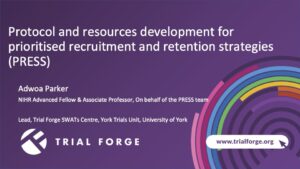Protocols and resources for priority recruitment and retention SWATs (PRESS)
Why we undertook the PRESS project
Clinical trials are important, but recruiting and retaining participants is challenging. Fewer than half of trials meet their recruitment goals, leading to wasted time, money, and effort for research teams and participants. Additionally, poor retention, when participants drop out before the study ends, comprises trial outcomes. Recruitment and retention problems therefore delay the identification and implementation of effective new treatments.
We conducted systematic reviews and discovered a notable lack of high-quality evidence to effectively guide decisions on recruitment and retention. One way of filling these gaps is to conduct a Study Within A Trial (SWAT). A SWAT is an evaluation done within a ‘host’ trial and can, for example, test whether a new retention strategy is better than an existing strategy. While SWATs are effective for testing recruitment and retention strategies, persuading trial teams to engage in this extra effort alongside their trials is tough. Interviews with Trial Forge SWAT Network institutions highlighted the need for resources like protocols, statistical analysis plans, intervention resources and ethical application templates, to support SWAT research
What was our goal?
The ‘Protocol and resource development for prioritised recruitment and retention strategies’ (PRESS) project aimed to develop these protocols, and resources, to assist and encourage trial teams to evaluate the recruitment and retention strategies in their trials, especially those that we have prioritised for evaluation.
What background work was necessary?
We wanted to create a list of recruitment and retention strategies that should be evaluated first, i.e., prioritised. The Trial Forge SWAT Network (40+ institutions) previously prioritised six recruitment and five retention strategies to be evaluated. Prioritisation was done by combining frequency of strategy use in NIHR HTA trials, evidence from the Cochrane recruitment and retention systematic reviews, a cost-effectiveness review and the findings of PRioRiTY I and II. There are many potentially suitable SWAT research questions that could be used to evaluate these strategies and we also listed an average of three SWAT questions for each strategy.
What did we do in PRESS?
The two protocols we used for PRESS (reflecting our two funding sources ) can be downloaded here: PRESS 1 protocol and PRESS 2 protocol.
We developed:
- A Master SWAT Protocol Template with a focus on facilitating replication of any SWAT undertaken
- Nine individual protocols for the prioritised recruitment and retention SWATs. We had 11 strategies, but two SWAT research questions are similar with others and the protocols can be adapted. Two of the prioritised SWATs focused on testing patient and public involvement (PPI) strategies for participant recruitment and retention. For these, we worked with three PPI partners to co-produce the two protocols.
- A resource pack for each protocol including:
- A guidance document for researchers applying for funding to conduct high-priority SWATs of recruitment and retention strategies https://osf.io/w6zym/
- Health Economics Guidance for undertaking randomised SWATs of recruitment and retention Strategies https://osf.io/sebnk/
- A randomised recruitment and retention SWAT Statistical Analysis Plan templates https://osf.io/h73ke/
The final protocols were reviewed by SWAT Trial Forge Network members and PPI partners and checked for language suitability.
Guidance, templates and protocol bundles can be downloaded from the links below. You can also look at the OSF site: https://osf.io/xfkgp/
General PRESS guidance and templates
Guidance for researchers applying for SWAT funding
This guidance document provides example wording to support researchers including a Trial Forge-prioritised SWAT, as part of a larger grant application to undertake a randomised trial. The prioritised SWATs focus on randomised SWATs of recruitment and retention strategies.
How to cite: Parker, A., Wilkinson, J. A., Treweek, S., Gkekas, A., Bruhn, H., Arundel, C., … Shiely, F. (2025, March 19). Guidance for Researchers Applying for Funding to Conduct High-Priority SWATs of Recruitment and Retention Strategies.
Statistical Analysis Plan template – recruitment
This document is a master template for the Statistical Analysis Plan for a recruitment SWAT.
How to cite: Sutton, C., Gkekas, A., Shiely, F., Treweek, S., Bruhn, H., Wilkinson, J. A., … Parker, A. (2025, March 29). PRESS Randomised Recruitment SWAT Master Statistical Analysis Plan Template. https://osf.io/vqt6g/files/osfstorage
Statistical Analysis Plan template – retention
This document is a master template for the Statistical Analysis Plan for a retention SWAT.
How to cite: Sutton, C., Gkekas, A., Shiely, F., Treweek, S., Bruhn, H., Wilkinson, J. A., … Parker, A. (2025, March 29). PRESS Randomised Retention SWAT Master Statistical Analysis Plan Template. Retrieved from https://osf.io/h73ke/files/osfstorage
Health economics guidance for SWAT researchers
This guidance provides a clear overview of the costs researchers should consider when undertaking a Trial Forge-prioritised SWAT, focusing on randomised SWATs of recruitment and retention strategies. It also offers advice on summarising and reporting SWAT-related costs.
How to cite: Gkekas, A., Shiely, F., Wilkinson, J. A., Sutton, C., Treweek, S., Bruhn, H., … Parker, A. (2025, March 19). Health Economics Guidance for Undertaking Randomised SWATs of Recruitment and Retention Strategies.
The Trial Forge Guidance 4 guidance for reporting SWATs
This article present the Trial Forge Guidance 4 guidance on reporting SWATs.
Guidance on making accessible documents
This document gives guidance on how to write accessible documents.
How to cite: Wilkinson, J. A., Bennett, A., Shiely, F., Treweek, S., Sterniczuk, K., Powponne, M., … Parker, A. (2025, March 20). Guidance on Making Accessible Documents. Retrieved from https://osf.io/8ek76
The protocols, linked guidance and resources
We have prepared nine protocols for SWAT evaluations of priority recruitment and retention interventions, each with its own bundle of resources. Hopefully these will make it easier for trial teams to include these SWATs in their trials.
For more help and information contact us at swats-group@york.ac.uk.
Recruitment SWATs
An evaluation of whether cash-based monetary incentives increase trial recruitment of people experiencing socioeconomic disadvantage compared to vouchers (CASH)
How to cite: Bruhn, H., Treweek, S., Parker, A., Sutton, C., Wilkinson, J. A., Arundel, C., … Shiely, F. (2025, March 28). An evaluation of whether cash-based monetary incentives increase trial recruitment of people experiencing socioeconomic disadvantage compared to vouchers (CASH): Study Within A Trial protocol. Retrieved from https://osf.io/6e2fz/
The resource bundle for the SWAT is at https://osf.io/6e2fz/files/osfstorage
The effectiveness and cost-effectiveness of a trial participant biography on participant recruitment rates (BIOREC)
How to cite: Parker, A., Bell, P., Bruhn, H., Wilkinson, J. A., Treweek, S., Arundel, C., … Shiely, F. (2025). The effectiveness and cost-effectiveness of a trial participant biography on participant recruitment rates (BIOREC): template Study Within A Trial protocol. Retrieved from https://osf.io/8kcdr/
The resource bundle for the SWAT is at https://osf.io/8kcdr/files/osfstorage
An evaluation of a theoretically informed written trial invitation compared to a standard written invitation to improve recruitment (INVITE)
How to cite: Bruhn, H., Treweek, S., Parker, A., Wilkinson, J. A., Sutton, C., Arundel, C., … Shiely, F. (2025, March 31). An evaluation of a theoretically informed written trial invitation compared to a standard written invitation to improve recruitment (INVITE): Study Within A Trial protocol. Retrieved from https://osf.io/r735x/files/osfstorage
The resource bundle for the SWAT is at https://osf.io/r735x/files/osfstorage
An evaluation of whether video(s) providing information about a trial increases recruitment of particular under-served groups, important for the trial, compared to written information only (VISUAL)
How to cite: Bruhn, H., Treweek, S., Parker, A., Sutton, C., Wilkinson, J. A., Arundel, C., … Shiely, F. (2025, March 29). An evaluation of whether video(s) providing information about a trial increases recruitment of particular under-served groups, important for the trial, compared to written information only (VISUAL): a Study Within A Trial protocol. Retrieved from https://osf.io/5mx4k/
The resource bundle for the SWAT is at https://osf.io/5mx4k/files/osfstorage
Retention SWATS
An evaluation of whether electronic reminders increase questionnaire completion rates compared to usual follow-up (E-PROMPT)
How to cite: Bruhn, H., Treweek, S., Parker, A., Wilkinson, J. A., Sutton, C., Arundel, C., … Shiely, F. (2025, March 30). An evaluation of whether electronic reminders increase questionnaire completion rates compared to usual follow-up (E-PROMPT): template Study Within A Trial protocol. Retrieved from https://osf.io/vbnj5/files/osfstorage
The resource bundle for the SWAT is at https://osf.io/vbnj5/files/osfstorage
An evaluation of whether monetary incentives increase trial questionnaire return rates (retention) compared to no monetary incentive (MONCENTIVES)
How to cite: Bruhn, H., Treweek, S., Parker, A., Wilkinson, J. A., Sutton, C., Arundel, C., … Shiely, F. (2025, March 30). An evaluation of whether monetary incentives increase trial questionnaire return rates (retention) compared to no monetary incentive (MONCENTIVES): template Study Within A Trial protocol. Retrieved from https://osf.io/t2gnf/files/osfstorage
The resource bundle for the SWAT is at https://osf.io/t2gnf/files/osfstorage
An evaluation of whether offering flexibility in in-person follow-up visit location increases trial participant retention compared to not offering flexibility (FLEXI)
How to cite: Bruhn, H., Treweek, S., Parker, A., Sutton, C., Wilkinson, J. A., Arundel, C., … Shiely, F. (2025, March 29). An evaluation of whether offering flexibility in in-person follow-up visit location increases trial participant retention compared to not offering flexibility (FLEXI): A cluster-randomised Study Within A Trial protocol. Retrieved from
The effectiveness and cost-effectiveness of trial newsletters, co-produced with Patient and Public Involvement (PPI) partners, on participant retention rates (NEWSLETTER)
How to cite: Wilkinson, J. A., Sterniczuk, K., Powponne, M., Bell, P., Shiely, F., Sutton, C., … Parker, A. (2025, March 31). The effectiveness and cost-effectiveness of trial newsletters, co-produced with Patient and Public Involvement (PPI) partners, on participant retention rates (NEWSLETTER): template Study Within A Trial protocol. Retrieved from https://osf.io/cv9ag/files/osfstorage
The resource bundle for the SWAT is at https://osf.io/cv9ag/files/osfstorage
An evaluation of whether using routinely collected data, to shorten a follow-up questionnaire, increases the retention of under-served groups, compared to using a longer, participant-reported questionnaire (SHORT-Q)
How to cite: Bruhn, H., Treweek, S., Parker, A., Wilkinson, J. A., Sutton, C., Arundel, C., … Shiely, F. (2025, March 30). An evaluation of whether using routinely collected data, to shorten a follow-up questionnaire, increases the retention of under-served groups, compared to using a longer, participant-reported questionnaire (SHORT-Q): template Study Within A Trial protocol. Retrieved from https://osf.io/m2bac/files/osfstorage
The resource bundle for the SWAT is at https://osf.io/m2bac/files/osfstorage
Insights
Here are a few insights from the PRESS team.
Adwoa Parker

Frances Shiely

FUNDING
The PRESS project (Protocol and resources development for prioritised recruitment and retention strategies) was co-funded by the MRC-NIHR TMRP (Medical Research Council – National Institute for Health Research Trial Methodology Research Partnership), UK, and the HRB TMRN (Health Research Board Trials Methodology Research Network), Ireland. Adwoa Parker was funded by the National Institute for Health and Care Research (Advanced Fellowship, reference: NIHR302256).
The views expressed are those of the authors and not necessarily those of the NIHR, HRB or the Department of Health and Social Care.




